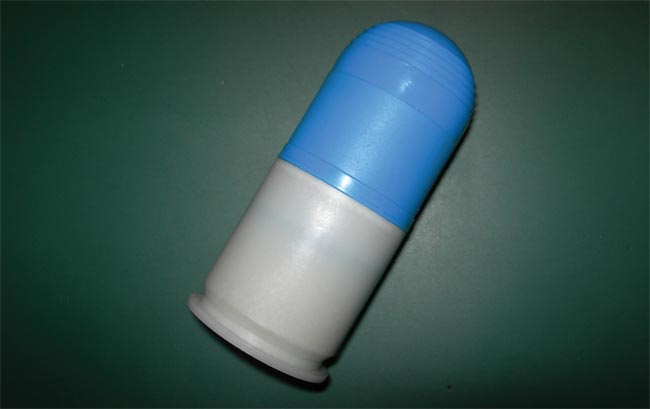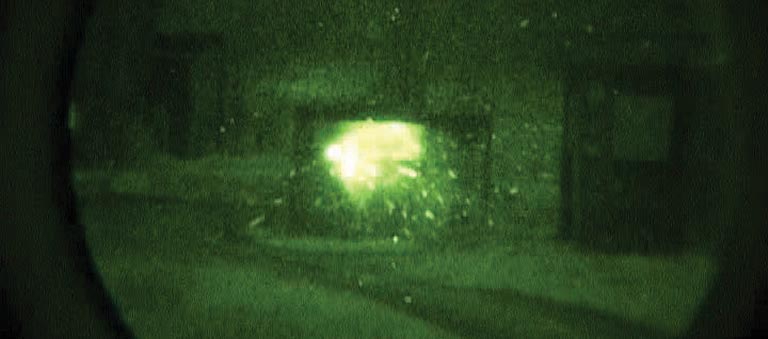In 2003 when the United States Special Operations Command (USSOCOM) identified a need for a 40mm day-night/low-velocity training cartridge, they went to the Army’s Program Executive Office Soldier and Naval Surface Warfare Center at Dahlgren. Both organizations had experience with Non-Dud Producing (NDP) ammo designs and the Foreign Comparative Testing (FCT) program. They had recently provided similar program support for the U.S. Marines’ NDP 40mm day and day-night/high-velocity training cartridges, MK281 Mod 0 and MK281 Mod 1, respectively.
In 2005, the German company behind the MK281 designs, Rheinmetall, received another opportunity to possibly equip American war-fighters through an FCT program. After proving their 40mm day-night/low-velocity training cartridge could meet Key Performance Parameters (KPP), the Navy awarded them a Product Design Build and Evaluation contract for a limited amount of test samples. In 2009 the German technology passed stringent U.S. test requirements.
Integrating Mature Technology through the Foreign Comparative Testing Program
“USSOCOM had outstanding Program Management support from both organizations. The Project Manager for Soldier Weapons, who reports to the PEO Soldier, led the XM1110 program for USSOCOM. NSWC Dahlgren led a program for a similar round, the MK312 Infrared Tactical Marking Cartridge. They were in charge of the FCT program,” commented Army Colonel, Kevin S. Noonan, USSOCOM’s PEO for SOF Warrior Systems. (Rheinmetall’s MK312 is a product derivative of XM1110.)
A typical ammunition development program requires a lengthy concept development and system integration phase in addition to a system demonstration prior to production and fielding. With an FCT program only a system demonstration is required. Essentially, the FCT capitalized on Rheinmetall’s already expended development time and costs in Europe. Accordingly, using FCT the USSOCOM Program Management team was able to significantly shorten qualification time and dramatically accelerate the fielding date.
“The FCT programs start with mature designs, and we’re able to complete an ammunition program in approximately three to four years. A normal ammunition program can take four to six years,” commented Colonel Noonan. “In many cases, USSOCOM FCT project managers partner with other service’s FCT projects to maximize common use of contracts, test facilities and other resources, which leads to significant cost savings and accelerated service-common certification needed to field the system.”
The FCT program is congressionally mandated. It provides funding for testing and evaluation of mature foreign technologies that can meet U.S. war-fighter operational requirements. By meeting KPPs ahead of testing and evaluation, developmental costs and schedule slips are minimized or eliminated. In the case of XM1110, USSOCOM began with a test firing to prove the cartridge could meet KPPs. It was unstable beyond 200m. Rheinmetall reengineered the design, and the program kicked off within a year.
Another program challenge involved testing protocols for the rough-handling tests. The new day-night XM1110 and the old day-only M781 have plastic noses that break on impact. The fragile nose design is part of the requirement to have a NDP cartridge. “During rough-handling tests, the XM1110 and M781 broke more often than expected. Since the M781 has not experienced high levels of breakage in the field during the last 30 years, it’s evident that the Military Standard rough-handling tests are considerably more severe than the conditions that the rounds actually encounter in the field. However, when fired into a soft target like tall grass, the XM1110 is almost twice as likely as the M781 to break open and function properly,” commented Colonel Noonan.
Nighttime Signatures without Perchlorate Flash-Bang Payloads
XM1110, like the U.S. Marine’s 40mm day-night/high-velocity MK281 Mod 1, is a NDP chemiluscent design. The environmentally friendly “glow-stick” component enables a distinctive nighttime signature without the potassium perchlorate flash-bang payload. War-fighters can now advance in night scenarios as they would in a real attack since the cartridge doesn’t leave behind Unexploded Ordnance (UXO) in the objective area.
“The XM1110 actually provides USSOCOM users with a new training capability. Because of the danger of duds, users would never have attempted a realistic live-fire exercise that would have ended with an assaulting force moving onto the target area. Users had to choose to either not use 40mm grenade launchers if they wanted to assault the objective or to fire into an impact area where they could not assault the objective. With XM1110, users will be able to fire all their hand-held weapons and then move into the target area to either consolidate on the objective or continue the attack as the training scenario may dictate. The XM1110 achieves the goal to enabling users to ‘train-as-they-fight’ during the night.”
USSOCOM was also concerned about training globally. The military puts a high value on international relations, which includes economic sensitivity towards the locals. Impoverished people collect UXO for scrap metal value, regardless of physical risk and clearly worded danger signs posted at military installations. Rheinmetall designs address this reality. Fired projectiles can be stepped on, rolled over, and picked up without risk of bodily harm. As well, buried projectiles don’t leach perchlorate toxins into groundwater. Since the same training challenges apply to the U.S. Marines, they intend to capitalize on the capabilities fit and procure XM1110 – ahead of USSOCOM.
USSOCOM user assessment for XM1110 was conducted in early 2009 in conjunction with their new MK13 Enhanced Grenade Launcher Module. End-users reported good accuracy and clear impact out to 350m with the naked eye. “Although this was never formally made a joint program, USSOCOM and the Marines Corps have been cooperating on this effort. Both USSOCOM and the Marine Corps are planning to buy XM1110 cartridges in 2009 with expected deliveries in 2010,” commented Colonel Noonan. “It’s not clear if the Army, Reserves and Guards will adopt the round. They’re in the process of determining if the XM1110 will satisfy their requirement.”
USSOCOM also included the U.S. Army Infantry Center in the process. Many of the requirements were originally proposed by the Infantry and later improved upon through end-user input in the development process. USSOCOM and the Army are phasing out the old M203 Grenade Launcher. The Army has transitioned to the new M320 Grenade Launcher Module.
Pushing Back on Unexploded Ordnance
USSOCOM, like the U.S. Marines, challenged industry to innovate. They both needed 40mm NDP cartridges with visual signatures for nighttime training. Industry stepped up and aligned tightly with U.S. Department of Defense directives. In turn, the Program Management team stepped up and leveraged the DoD’s FCT program. Consequently, a global problem was addressed: Unexploded Ordnance.
“Rheinmetall cartridges have perchlorate-free chemiluscent payloads,” commented Derek Dunaway, CEO of Cyalume Technologies in Massachusetts. “Our payload makes nighttime training possible without harming people, property, or the environment. The cartridges would not have made it this far without the FCT program. FCT puts the war-fighters’ needs first and enables small companies like Cyalume to innovate, team up, and collaborate alongside larger companies in the manufacturing process.”
Rheinmetall’s 40mm product portfolio is challenging small companies to learn new ammunition designs. This type of stimulation is needed in the economy and is welcomed in the industrial bases. “The best example of manufacturing green technology through the FCT program with a small business is the XM1110 training cartridge project for USSOCOM,” commented Colonel Richard Eric Burns, Director, FCT Office. “While the 40mm rounds were originally developed by Rheinmetall of Germany, Rheinmetall teamed with an American partner Cyalume in Massachusetts for its glow-stick component and used Spectra Technologies, a subcontractor in Arkansas, who will be used to assemble the final rounds once the production contract has been awarded.”
Like the fledgling American solar energy industry, the U.S. military is reaching out globally for immediate solutions. This “force readiness” decision is bringing much needed competition to an emerging global “green ammunition” industrial base. When greener training cartridges are integrated, war-fighters are deservingly equipped with the most advanced technology that’s available. That’s the innovation focus the DoD had in mind when they stood up the FCT program. Align to the war-fighters needs, and from that alignment the needs of society will be met.
“There is no statutory requirement for production in the U.S. However, many FCT procurements have led to technology licensing agreements with foreign developers, providing technology manufacturing in 33 U.S. states. This was done for a number of reasons: cheaper for the vendor, faster delivery, ready repair facilities, and logistics considerations; or to comply with the Buy America Act and Berry Amendment; or to take advantage of the production facilities that already exist,” commented Colonel Burns.
Rheinmetall understood in the late 1990s that addressing UXO was a priority with the DoD. They teamed up selectively, and they positioned their technology selectively. The German-engineered 40mm designs are the only American manufactured perchlorate-free NDP cartridges in the United States. There’s no other 40mm NDP technology that enables nighttime training, while addressing pressing social concerns over UXO and perchlorate leaching.
The DoD has detail intensive UXO reports from the Defense Science Board, dated 1996 and 2003. Scientists and researchers unanimously agree that 40mm NDP technology is a critical component in resolving UXO. 40mm cartridges are among the most frequently excavated on Base Re-Alignment and Closure (BRAC) land, Formerly Used Defense Sites (FUDS), and ranges.
The cost of standing still when it comes to resolving UXO is staggering. The U.S. military uses 12+ million 40mm training cartridges annually. Digging up the ones that get buried costs $500+ million annually. In 2007 the U.S. Marine Corp was recognized in Congress as UXO trendsetters for the MK281 program. Like them, USSOCOM has made a remarkable social contribution with the XM1110 program. With the combined efforts of the DoD, program management like PM Soldier Weapons and NSWC at Dahlgren, and the FCT program – we have all benefited by the U.S. military reaching out globally.
For product information contact American Rheinmatall Munition, Inc at 703-221-9286.
(Note: Due to budget constraints, as of July 10, 2009 USSOCOM command had to shift funding priorities. U.S. Marine Corps will lead acquisition efforts and procure the new cartridge. USSOCOM can procure when funding improves.)











